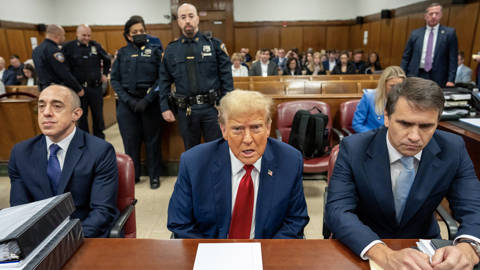CAMBRIDGE – What is money? Some have described it as a shared fiction, or as a form of collective memory. To document and facilitate transactions between parties, we have relied on everything from seashells and rare metals to strips of paper and – more recently – entries in digital ledgers.
These technologies all facilitate the creation, transfer, and destruction of value, and each works only because a group of participants – a “tribe” – has reached a fundamental agreement about what holds monetary value. It is this underlying agreement that enables the use of money to measure credits and debits and record exchanges among market participants. The users of money must be confident that it will remain exchangeable for goods and services; and the larger the group of users, the more useful that money becomes.
A crucial question for any monetary arrangement is who, if anyone, has the power to create money, take it out of circulation, and determine how it can be used. While we often think of money as inherently fungible, modern societies regularly restrict the supply and use of money in order to achieve broader goals, such as keeping prices stable and fighting financial crime.
In practice, then, societies create and maintain a consensus about money through a combination of technology and institutions. While technology can enable better forms of money, when and how such new forms are actually adopted depends critically on the presence or absence of complementary institutions. As Jacob Goldstein recounts in his recent book Money: The True Story of a Made-Up Thing, it took centuries for the institutions built by Genghis Khan (who introduced the first paper currency in 1227) to turn the technology of printing plates and paper notes into modern money. The notes’ redeemability for silver or bronze first had to be broken.
The Bitcoin Breakthrough
Cryptocurrencies represent the latest iteration of this long historical process. From its conception in a 2008 white paper by Satoshi Nakamoto (a pseudonym) to its peak valuation this year, Bitcoin has gained traction during a period of unusually low trust in the traditional institutions behind money in the developed world.
Beyond a clever new technology, what Nakamoto was (or were) really proposing was a new type of institutional arrangement. With Bitcoin, reaching an agreement about the value of money does not require trusted third parties like central banks or financial intermediaries. Instead, Bitcoin relies on a combination of cryptography and game theory to allow currency holders to reach a consensus about the supply, individual balances, and transfers of what they hope will become a new form of money.
To establish, update, and secure its digital ledger, Bitcoin depends on investments by a decentralized network of infrastructure providers called “miners.” To provide miners with an incentive to perform the computations needed to secure and process the exchange of Bitcoin, the Bitcoin protocol rewards them for each batch of transactions with the associated transaction fees and a decreasing amount of newly minted Bitcoin. But while this process minimizes the need for trusted third parties, the computation by miners comes at a significant environmental cost, owing to the massive electricity use it requires.
Moreover, to the extent that we rely on institutions to ensure that the use of money adheres to our values and principles, Bitcoin’s design can become either a major strength or a serious weakness. In places where institutions are weak, undemocratic, or openly repressive, Bitcoin can provide its users with a more equal and robust store of value than anything they can access through the local financial system. But Bitcoin on its own does not come with any recourse or protections against theft, loss, or broader forms of financial crime. Because there are no third parties, users are left to their own devices. Bitcoin’s neutrality also inevitably means that benign and malign actors have equal access to the system.
To address these problems, new types of intermediaries such as custodial wallets have emerged. But, of course, these actors are replicating some of the features of the traditional financial system that Bitcoin was supposed to overcome.
This highlights a key point: the social contract underpinning Bitcoin is unambiguously less compelling in places with strong institutions. When people have come to enjoy sound monetary policy, a range of consumer protection laws, and government guarantees such as deposit insurance against bank failure, Bitcoin’s institution-light design has less to recommend it, and its environmental costs seem all the more outrageous.
Nonetheless, while some traditional institutions have been able to withstand fraught market and political conditions over the last few decades, Bitcoin and other cryptocurrencies remain an alternative for when those institutions turn out to be more fragile than expected. Similarly, cryptocurrencies can offer a way to restore competitive conditions when intermediaries have accumulated too much market power.
Designing Cryptocurrencies
Each cryptocurrency places different weights on key inputs such as technology, institutions, and the beliefs of its supporting tribe in the provision of money. The weights across these inputs are design choices, which is why we have seen an explosion of cryptocurrency experiments. So far, each promising design has given rise to complementary intermediaries that counterbalance the design’s key weaknesses.
For example, by default, cryptocurrency holders (or “HODLers”) have no way to access their coins if they forget their private keys. As a result, consumers often hold cryptocurrency through centralized intermediaries – crypto wallets – that provide them with the familiar password-recovery and access-protection features they know from online banking.
Worried about energy consumption, cryptocurrency developers have also started exploring different incentive systems and technological solutions to replace wasteful computation with more energy-efficient models. Systems based on proof of stake, for example, can establish a consensus about a transaction faster by giving more weight to information presented by larger coin-holders. This ensures that as long as the majority of a coin’s holdings are in the hands of honest participants, the system correctly represents reality. But it also inevitably gives large coin-holders disproportionate influence over the process.
Proof-of-stake systems’ reliance on weighting votes by holdings stems from the fact that coin balances can be easily verified on a digital ledger without access to any outside information. Moving a proof-of-stake system away from a coin-based plutocracy and toward more representative governance thus would depend on the availability of additional information. Identity verification, for example, could be used to give each participant a single vote. But, of course, only third parties, typically governments, currently can reliably maintain the bridge between a person’s real identity and their online representation.
Disintermediating Wall Street?
The wave of innovation that started with cryptocurrencies is not limited to “money” per se. Designs have rapidly ventured away from storage and transfer of value to more complex financial arrangements. Decentralized finance (DeFi), as the name suggests, uses digital-ledger technology to create decentralized financial markets.
For example, decentralized exchanges (“DEXes”) match buyers and sellers of cryptocurrency without requiring users to trust or assign custody of their assets to a traditional exchange. By removing regulated exchanges from the picture, DEXes could improve competition, efficiency, and transparency, although they also introduce significant challenges in areas such as compliance. New intermediaries may emerge to meet DeFi participants’ maturing needs – as has already happened with crypto wallets. But in the absence of intermediaries, it will be extremely difficult to safeguard consumers and ensure financial stability, and regulators may have to achieve their goals in new ways, including by trying the more challenging route of regulating user access or transactions directly.
Thus, while DeFi may eventually bring greater transparency, automation, and competition, it also could reduce our ability to ensure that financial markets reflect values and principles beyond the profit motive. While some will see this as an improvement, others may wonder how these systems will stop participants from exploiting insider information, manipulating the market, or destabilizing the system as a whole for their own benefit.
The Token Ownership Society
If someone had asked us to predict where cryptocurrency enthusiasts would move next, digital art would not have been our first guess. But with hindsight, the rise of non-fungible tokens (NFTs) at a time when investors are frantically seeking new assets to invest in makes perfect sense. Art can be an expression of a tribe’s enthusiasm, and that enthusiasm can be channeled into a platform – and associated institutional arrangements – supporting decentralized engagement, social discourse, and related economic transactions.
Unlike Bitcoin, where coins need to be fungible to be used as money, NFTs are meant to be one-of-a-kind. As such, they offer a solution to a longstanding puzzle: in a world where digital copies are costless to produce and indistinguishable from their originals, artists must rely wholly on external enforcement through copyright laws to control the sale and use of any copy after the first. Worse, by merely displaying their art in its unaltered form on the web, artists make it easy for anyone to take a copy for free.
By linking easy-to-replicate digital art with a unique token representing canonical (“original”) ownership, NFTs restore creators’ ability to design agreements and rights relating to the use and distribution of their work. Critical to this arrangement is the connection between the easy-to-copy object and its digital token. As with cryptocurrencies and fiat money, whether this link confers any value to the token depends on a tribe reaching agreement about how the link is established, maintained, and/or destroyed. If those with confidence in it lose faith or move on to something else, NFT holders would be left with nothing but a worthless bundle of bits.
Like cryptocurrencies and fiat money, NFTs therefore derive their value from group beliefs and consensus. In the case of money, the medium’s usefulness grows with the size of the tribe. But with a new NFT protocol, the key issue is whether its design choices are well suited to a specific tribe’s idiosyncratic needs and preferences.
By adding programmability to digital assets, NFTs allow a group of creators and their audiences to track ownership of digital artifacts, consume and recombine different media into new products and services, and build novel business models around them. In the same way that cryptocurrencies enable the unbundling of financial services, NFTs open opportunities for new types of content curation and distribution. After all, a single NFT can be divided into fungible ownership shares, allowing multiple parties to split economic and control rights over a single object (be it art, a meme, a digital baseball card, or even real estate). And because the underlying code for NFTs is open and programmable, the potential for recombination across formats and monetization strategies may resemble what we observed with the early internet.
For example, in a world in which music rights can be enforced through rules written into an NFT, a musician linking a song to a token could distribute her work not through a single streaming channel but through a number of different platforms – all by licensing access through the token. Moreover, the token itself could share compensation with other tokenized assets, such as those associated with a song sampled or remixed within the artist’s track. And if a musician got off the ground and recorded a song thanks to a group of crowdfunders, those supporters could receive a share of the future revenues.
In this world, newspapers, streaming platforms, social networks, and marketplaces may face more competition. Owing to the interoperable nature of NFT-based networks, online content – digital representations of offline goods, social profiles, and interactions – becomes more portable and modular across providers. As such, consumers may benefit from more choice concerning the types of intermediaries they rely on, and businesses may be able to tap into new types of economic arrangements. Regulators have long been looking for ways to limit the power that platform architects retain over digital ecosystems; by advancing interoperability, NFTs and cryptocurrencies could be part of the solution.
The Crucial Interplay
While it may be tempting to think of cryptocurrencies as yet another instance in which “software is eating the world,” the journey from Bitcoin through DeFi to NFTs implies a much more nuanced interplay between code and institutions. For any cryptocurrency experiment to last and be ultimately useful, society will need to develop complementary institutions supporting it. Paradoxically, the types of constraints institutions may impose on crypto technology are precisely the ones that will allow the technology to channel our values and reach mainstream adoption.






CAMBRIDGE – What is money? Some have described it as a shared fiction, or as a form of collective memory. To document and facilitate transactions between parties, we have relied on everything from seashells and rare metals to strips of paper and – more recently – entries in digital ledgers.
These technologies all facilitate the creation, transfer, and destruction of value, and each works only because a group of participants – a “tribe” – has reached a fundamental agreement about what holds monetary value. It is this underlying agreement that enables the use of money to measure credits and debits and record exchanges among market participants. The users of money must be confident that it will remain exchangeable for goods and services; and the larger the group of users, the more useful that money becomes.
A crucial question for any monetary arrangement is who, if anyone, has the power to create money, take it out of circulation, and determine how it can be used. While we often think of money as inherently fungible, modern societies regularly restrict the supply and use of money in order to achieve broader goals, such as keeping prices stable and fighting financial crime.
In practice, then, societies create and maintain a consensus about money through a combination of technology and institutions. While technology can enable better forms of money, when and how such new forms are actually adopted depends critically on the presence or absence of complementary institutions. As Jacob Goldstein recounts in his recent book Money: The True Story of a Made-Up Thing, it took centuries for the institutions built by Genghis Khan (who introduced the first paper currency in 1227) to turn the technology of printing plates and paper notes into modern money. The notes’ redeemability for silver or bronze first had to be broken.
The Bitcoin Breakthrough
Cryptocurrencies represent the latest iteration of this long historical process. From its conception in a 2008 white paper by Satoshi Nakamoto (a pseudonym) to its peak valuation this year, Bitcoin has gained traction during a period of unusually low trust in the traditional institutions behind money in the developed world.
Beyond a clever new technology, what Nakamoto was (or were) really proposing was a new type of institutional arrangement. With Bitcoin, reaching an agreement about the value of money does not require trusted third parties like central banks or financial intermediaries. Instead, Bitcoin relies on a combination of cryptography and game theory to allow currency holders to reach a consensus about the supply, individual balances, and transfers of what they hope will become a new form of money.
SPRING SALE: Save 40% on all new Digital or Digital Plus subscriptions
Subscribe now to gain greater access to Project Syndicate – including every commentary and our entire On Point suite of subscriber-exclusive content – starting at just $49.99.
Subscribe Now
To establish, update, and secure its digital ledger, Bitcoin depends on investments by a decentralized network of infrastructure providers called “miners.” To provide miners with an incentive to perform the computations needed to secure and process the exchange of Bitcoin, the Bitcoin protocol rewards them for each batch of transactions with the associated transaction fees and a decreasing amount of newly minted Bitcoin. But while this process minimizes the need for trusted third parties, the computation by miners comes at a significant environmental cost, owing to the massive electricity use it requires.
Moreover, to the extent that we rely on institutions to ensure that the use of money adheres to our values and principles, Bitcoin’s design can become either a major strength or a serious weakness. In places where institutions are weak, undemocratic, or openly repressive, Bitcoin can provide its users with a more equal and robust store of value than anything they can access through the local financial system. But Bitcoin on its own does not come with any recourse or protections against theft, loss, or broader forms of financial crime. Because there are no third parties, users are left to their own devices. Bitcoin’s neutrality also inevitably means that benign and malign actors have equal access to the system.
To address these problems, new types of intermediaries such as custodial wallets have emerged. But, of course, these actors are replicating some of the features of the traditional financial system that Bitcoin was supposed to overcome.
This highlights a key point: the social contract underpinning Bitcoin is unambiguously less compelling in places with strong institutions. When people have come to enjoy sound monetary policy, a range of consumer protection laws, and government guarantees such as deposit insurance against bank failure, Bitcoin’s institution-light design has less to recommend it, and its environmental costs seem all the more outrageous.
Nonetheless, while some traditional institutions have been able to withstand fraught market and political conditions over the last few decades, Bitcoin and other cryptocurrencies remain an alternative for when those institutions turn out to be more fragile than expected. Similarly, cryptocurrencies can offer a way to restore competitive conditions when intermediaries have accumulated too much market power.
Designing Cryptocurrencies
Each cryptocurrency places different weights on key inputs such as technology, institutions, and the beliefs of its supporting tribe in the provision of money. The weights across these inputs are design choices, which is why we have seen an explosion of cryptocurrency experiments. So far, each promising design has given rise to complementary intermediaries that counterbalance the design’s key weaknesses.
For example, by default, cryptocurrency holders (or “HODLers”) have no way to access their coins if they forget their private keys. As a result, consumers often hold cryptocurrency through centralized intermediaries – crypto wallets – that provide them with the familiar password-recovery and access-protection features they know from online banking.
Worried about energy consumption, cryptocurrency developers have also started exploring different incentive systems and technological solutions to replace wasteful computation with more energy-efficient models. Systems based on proof of stake, for example, can establish a consensus about a transaction faster by giving more weight to information presented by larger coin-holders. This ensures that as long as the majority of a coin’s holdings are in the hands of honest participants, the system correctly represents reality. But it also inevitably gives large coin-holders disproportionate influence over the process.
Proof-of-stake systems’ reliance on weighting votes by holdings stems from the fact that coin balances can be easily verified on a digital ledger without access to any outside information. Moving a proof-of-stake system away from a coin-based plutocracy and toward more representative governance thus would depend on the availability of additional information. Identity verification, for example, could be used to give each participant a single vote. But, of course, only third parties, typically governments, currently can reliably maintain the bridge between a person’s real identity and their online representation.
Disintermediating Wall Street?
The wave of innovation that started with cryptocurrencies is not limited to “money” per se. Designs have rapidly ventured away from storage and transfer of value to more complex financial arrangements. Decentralized finance (DeFi), as the name suggests, uses digital-ledger technology to create decentralized financial markets.
For example, decentralized exchanges (“DEXes”) match buyers and sellers of cryptocurrency without requiring users to trust or assign custody of their assets to a traditional exchange. By removing regulated exchanges from the picture, DEXes could improve competition, efficiency, and transparency, although they also introduce significant challenges in areas such as compliance. New intermediaries may emerge to meet DeFi participants’ maturing needs – as has already happened with crypto wallets. But in the absence of intermediaries, it will be extremely difficult to safeguard consumers and ensure financial stability, and regulators may have to achieve their goals in new ways, including by trying the more challenging route of regulating user access or transactions directly.
Thus, while DeFi may eventually bring greater transparency, automation, and competition, it also could reduce our ability to ensure that financial markets reflect values and principles beyond the profit motive. While some will see this as an improvement, others may wonder how these systems will stop participants from exploiting insider information, manipulating the market, or destabilizing the system as a whole for their own benefit.
The Token Ownership Society
If someone had asked us to predict where cryptocurrency enthusiasts would move next, digital art would not have been our first guess. But with hindsight, the rise of non-fungible tokens (NFTs) at a time when investors are frantically seeking new assets to invest in makes perfect sense. Art can be an expression of a tribe’s enthusiasm, and that enthusiasm can be channeled into a platform – and associated institutional arrangements – supporting decentralized engagement, social discourse, and related economic transactions.
Unlike Bitcoin, where coins need to be fungible to be used as money, NFTs are meant to be one-of-a-kind. As such, they offer a solution to a longstanding puzzle: in a world where digital copies are costless to produce and indistinguishable from their originals, artists must rely wholly on external enforcement through copyright laws to control the sale and use of any copy after the first. Worse, by merely displaying their art in its unaltered form on the web, artists make it easy for anyone to take a copy for free.
By linking easy-to-replicate digital art with a unique token representing canonical (“original”) ownership, NFTs restore creators’ ability to design agreements and rights relating to the use and distribution of their work. Critical to this arrangement is the connection between the easy-to-copy object and its digital token. As with cryptocurrencies and fiat money, whether this link confers any value to the token depends on a tribe reaching agreement about how the link is established, maintained, and/or destroyed. If those with confidence in it lose faith or move on to something else, NFT holders would be left with nothing but a worthless bundle of bits.
Like cryptocurrencies and fiat money, NFTs therefore derive their value from group beliefs and consensus. In the case of money, the medium’s usefulness grows with the size of the tribe. But with a new NFT protocol, the key issue is whether its design choices are well suited to a specific tribe’s idiosyncratic needs and preferences.
By adding programmability to digital assets, NFTs allow a group of creators and their audiences to track ownership of digital artifacts, consume and recombine different media into new products and services, and build novel business models around them. In the same way that cryptocurrencies enable the unbundling of financial services, NFTs open opportunities for new types of content curation and distribution. After all, a single NFT can be divided into fungible ownership shares, allowing multiple parties to split economic and control rights over a single object (be it art, a meme, a digital baseball card, or even real estate). And because the underlying code for NFTs is open and programmable, the potential for recombination across formats and monetization strategies may resemble what we observed with the early internet.
For example, in a world in which music rights can be enforced through rules written into an NFT, a musician linking a song to a token could distribute her work not through a single streaming channel but through a number of different platforms – all by licensing access through the token. Moreover, the token itself could share compensation with other tokenized assets, such as those associated with a song sampled or remixed within the artist’s track. And if a musician got off the ground and recorded a song thanks to a group of crowdfunders, those supporters could receive a share of the future revenues.
In this world, newspapers, streaming platforms, social networks, and marketplaces may face more competition. Owing to the interoperable nature of NFT-based networks, online content – digital representations of offline goods, social profiles, and interactions – becomes more portable and modular across providers. As such, consumers may benefit from more choice concerning the types of intermediaries they rely on, and businesses may be able to tap into new types of economic arrangements. Regulators have long been looking for ways to limit the power that platform architects retain over digital ecosystems; by advancing interoperability, NFTs and cryptocurrencies could be part of the solution.
The Crucial Interplay
While it may be tempting to think of cryptocurrencies as yet another instance in which “software is eating the world,” the journey from Bitcoin through DeFi to NFTs implies a much more nuanced interplay between code and institutions. For any cryptocurrency experiment to last and be ultimately useful, society will need to develop complementary institutions supporting it. Paradoxically, the types of constraints institutions may impose on crypto technology are precisely the ones that will allow the technology to channel our values and reach mainstream adoption.